When it comes to city passes and travel cards, it’s usually fairly easy to figure out whether they would be worth it for you or not. For things like the Paris Pass or London Pass, they have a list of the most popular attractions and how much they cost, right there for you to see. The Swiss Travel Pass, however, is shrouded in mystery, or at least it was until I spent several days tracking down all of the prices and benefits.
A great many of the visitors and commenters on my popular page about where to go in Switzerland on a short visit are wondering whether the Swiss Travel Pass is a good deal. Embarrassingly, I’ve always had to answer that I found the pass too confusing to confidently advise people on. Now that has all changed, after literally days of research.
Note: This article was last updated in February, 2024.
Disclosure: This is a reader-supported website and some of the links are affiliate links where a small commission is paid to help keep this site going, but the cost to visitors is the same. The Swiss Travel Pass seems quite expensive at first, so it felt like it might be hard to get your money’s worth out of it. As it turns out, it’s pretty easy to get good value, and it’ll be a good deal for many visitors.
New in 2024
Prices increased an average of 5.9% from 2023 on the Swiss Travel Passes, but the Half Fare Card remains at CHF120, which is where it’s been for many years. Train fares in the country increased by similar percentages so the value is basically unchanged. There were no other notable changes to service or the included attractions and train routes.
>>>Buy the Swiss Travel Pass online
Where to stay in Interlaken and the Lauterbrunnen Valley
Since most people reading this will be visiting the Interlaken area and I get so many questions about it, I decided to write a detailed guide on which area to stay in while visiting this area.
>>>Where to stay in Interlaken or the Lauterbrunnen Valley in Switzerland
I included many huge photos in that post so readers will be able to get a better idea of what each place looks like and they are worth a look by itself.
>>>Lucerne or Interlaken: Which to visit and how long to stay?
The article just above will help you decide on how long to spend in each of Switzerland’s two best tourist areas.
Are you 100% sure where you want to go in Switzerland? This should help
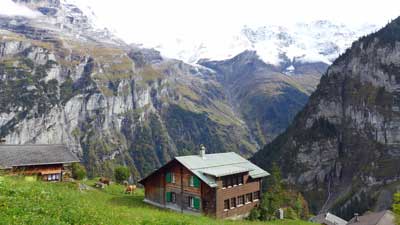
Zurich and Geneva are pleasant but dull. The good news is that Switzerland is packed with amazing sights and none of them are the big cities. If you aren’t 100% locked in yet, please read the article below and I think you’ll enjoy it.
Is the Swiss Travel Pass a good deal? Here's the short version
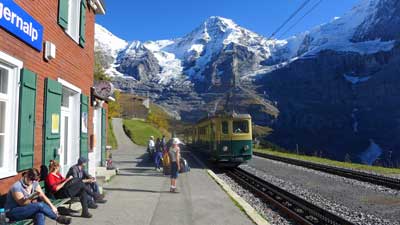
The bottom line is that the scenery, train journeys, and cable car rides in Switzerland are stunning and not found anywhere else in the world. They are also quite expensive if you pay for them one at a time. So no matter how you visit Switzerland, you are going to be paying quite a bit, or skipping the absolute best things that you’ve come there to see.
With good planning it’s quite easy to get great value out of a Swiss Travel Pass, but it might be a poor choice for those who don’t like to plan ahead. You can easily do a scenic train ride and a cable car in the same day, and still have time to do a scenic hike in the process.
First class or second class? Good news for most people
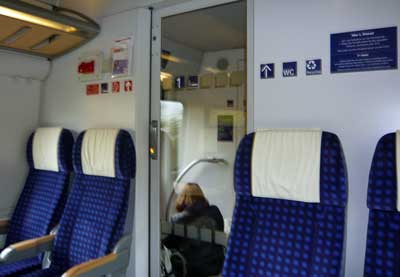
That said, Swiss Trains are literally the nicest in Europe and even the Second Class seats and carriages are nicer and roomier than trains in neighboring countries. The First Class seats are larger and nicer with only 3 across the cabin instead of 4, but honestly Second Class is perfectly comfortable for almost everyone.
Again, First Class on European trains like this is generally popular with business travelers where the company is paying and they need to get work done during the ride, and also senior citizens who don’t want to worry about a carriage full of backpackers. For most of the rest of us, Second Class is more than comfortable enough and the seat width and legroom compare to business-class airline seats. I’m a big and tall guy and I almost always travel in Second because it’s plenty comfortable enough and all the seats arrive at the same time anyway.
The longer you'll be in Switzerland, the better deal a Swiss Travel Pass will be
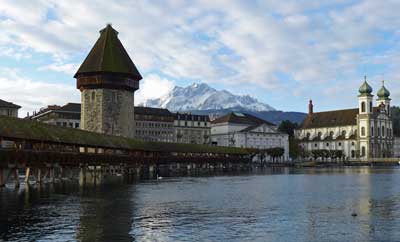
In other words, if you are staying 5 days or fewer, you have to do the math to determine your best option. But if you are spending even 6 or 7 days in Switzerland then the 6-day or 8-day Pass is almost guaranteed to be a great deal and your best choice. Once you have a Swiss Travel Pass you’ll absolutely love the ability to just hop on any train (excellent trains, always on time) and most boats and cable cars without having to worry about the cost. The per-day cost of an 8-day Pass even if you only use 6 of those days is about CHF65, and Switzerland is filled with amazing train rides and boats and cable cars that can get you that much value before noon each day.
Schilthorn (50% discount) and Jungfraujoch (25% discount) are cheaper with a Swiss Travel Pass
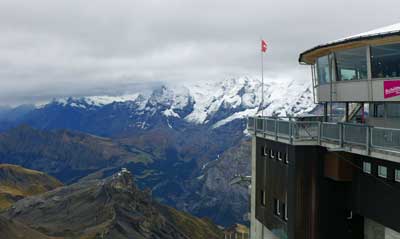
Both of those peak experiences are extraordinary and different from each other. Even so, compared to Jungfraujoch, Schilthorn is also faster and more comfortable on the way up and down. You can enjoy an excellent visit to Schilthorn in 4 hours or so (or a bit longer if you eat at the spinning Piz Gloria restaurant at the top), while a visit to Jungfraujoch requires closer to 6 hours.
NOTE: Schilthorn closes for maintenance for a week or two in late November most years.
Consider the Swiss Half-Fare Card instead
If you AREN’T going to be doing two or more of the long (and expensive) scenic train trips, you will get much better value out of the Swiss Half-Fare Card, which is explained a bit below.
Mt Rigi, near Lucerne, is 100% covered by the Swiss Travel Pass
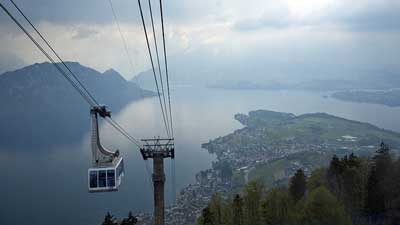
Is a Swiss Travel Pass right for you?
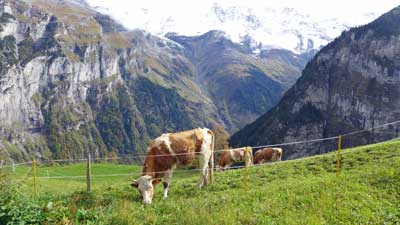
Most people only visit Switzerland for 5 or 6 days at most, so the 3-day and 4-day passes are the ones to focus on. But if you are staying for 8 days or more, those longer passes are almost certainly a great deal for you.
Long story short, if you plan on doing 2 of the more expensive scenic trains and the Jungfraujoch railway or the Schilthorn cable car, then the pass will save you money. Switzerland is expensive, but it’s worth it, and the travel pass can help make it a bit more affordable.
What the Swiss Travel Pass includes
- Free rail travel on normal trains and most scenic trains
- Discounted travel (about 50%) on popular tourist mountain trains
- Discounted travel (about 50%) on popular tourist cable cars
- Free travel on public transport in 75 towns and cities
- Free entry to around 500 museums in Switzerland
The Swiss Travel Pass covers the fare on the most popular scenic and panoramic trains. You can choose a normal seat in a regular carriage for no additional cost, but there is a supplement of CHF8 to CHF49 for a reserved seat in one of the special panorama carriages on these routes.
Prices of the 2024 Swiss Travel Pass
1st Class
- Adult 3-day Pass: CHF389
- Youth (4 to 25) 3-day Pass: 274
- Adult 4-day Pass: 469
- Youth (4 to 25) 4-day Pass: 330
- Adult 6-day Pass: 602
- Youth (4 to 25) 6-day Pass: 424
- Adult 8-day Pass: 655
- Youth (4 to 25) 8-day Pass: 469
- Adult 15-day Pass: 723
- Youth (4 to 25) 15-day Pass: 512
2nd Class
- Adult 3-day Pass: CHF244
- Youth (4 to 25) 3-day Pass: 172
- Adult 4-day Pass: 295
- Youth (16 to 25) 4-day Pass: 209
- Adult 6-day Pass: 379
- Youth (16 to 25) 6-day Pass: 268
- Adult 8-day Pass: 419
- Youth (16 to 25) 8-day Pass: 297
- Adult 15-day Pass: 459
- Youth (16 to 25) 15-day Pass: 328
Swiss Travel Pass Flex
This version costs a bit more, but you don’t have to use the travel days consecutively. It’s a great option for anyone who won’t be taking longer train rides each day.
- Adult 3 Flex days in 1 month (1st Class): CHF445
- Adult 3 Flex days in 1 month (2nd Class): 279
- Adult 4 Flex days in 1 month (1st Class): 539
- Adult 4 Flex days in 1 month (2nd Class): 339
- Adult 6 Flex days in 1 month (1st Class): 644
- Adult 6 Flex days in 1 month (2nd Class): 405
- Adult 8 Flex days in 1 month (1st Class): 697
- Adult 8 Flex days in 1 month (2nd Class): 439
- Adult 15 Flex days in 1 month (1st Class): 755
- Adult 15 Flex days in 1 month (2nd Class): 472
Where to buy the Swiss Travel Pass
The Swiss Half-Fare Card – A better option for many visitors
Far less confusing than the Swiss Travel Pass, you can instead get a Swiss Half-Fare Card, and it will be a better deal for many travelers. The price is lower and it’s much easier to do the math, and the discounts are greater on some things as well.
- Swiss Half-Fare Card for 30 days: Adults – CHF120 or US$129
What you get:
Those who buy the Swiss Half-Fare Card will get 50% discount on all trains, buses, and boats in Switzerland for up to 30 days, as well as 50% off all public transportation in 75 cities and towns.
>>>Buy the Swiss Half-Fare Card
Why the Half-Fare Card is a better deal for many
While the Swiss Travel Pass is a great deal for those doing many of the expensive scenic journeys and mountain sights within a few days, it’s not good value for those who are doing fewer of the expensive trips and/or those who are staying longer. Also, the Swiss Travel Pass only provides a 25% discount on the amazing Jungfraujoch Railway, which costs between CHF120 and CHF224 return depending on your starting point, while the Half-Fare Card provides a 50% discount.
The math is simple as well. You can just add up the cost of the trains, boats, and buses you’ll be taking while in Switzerland, and if the total is more than CHF240 or so, the Half-Fare Card will save you money.
Example itinerary:
- Zurich to Interlaken train (2nd Class): CHF50
- Schilthorn Cable Car: CHF112
- Jungfraujoch railway from Interlaken: CHF205
- Interlaken to Lucerne train (2nd Class): CHF33
- Mt Rigi roundtrip from Lucerne: CHF84
- Engelberg (near Lucerne) to Mt. Titlis Cable Car: CHF92
- Lucerne to Zurich train (2nd Class): CHF25
Total per person: CHF601
Total with Half-Fare Card (including price of card): CHF420.50
It would be tough to do all of those things in 4 days, although it is possible. If you bought a 4-day Swiss Travel Pass here is how it adds up:
4-Day Swiss Travel Pass: CHF259
Supplements for Schilthorn, Jungfraujoch, and Mt. Titlis: CHF203.25
Total cost: CHF462.25
Bottom line on the Swiss Half-Fare Card
Since the Half-Fare Card lasts 30 days and provides a larger discount on Jungfraujoch, it is better value for visitors who want to include that scenic top-of-Europe rail journey on their trip. The discounts also add up more quickly on Schilthorn and Mt. Titlis trips, just to name two examples, and you don’t have to take many longer rail journeys to get value out of the Half-Fare Card.
Swiss Saver Day Pass (A one-day unlimited travel pass)
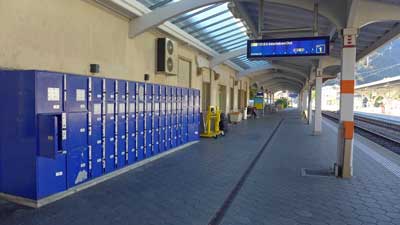
If you buy the Saver Day Pass at least 21 days in advance (and up to 60 days in advance) the 2023 cost is:
- 2nd Class (with Half Fare Card): CHF29
- 1st Class (with Half Fare Card): CHF82
- 2nd Class (with no Half Fare Card): CHF52
- 1st Class (with no Half Fare Card): CHF97
Once you research the normal cost of Swiss train fares you’ll see that the above prices are a very good deal for anyone riding more than 150 kilometers or so in a day. If you are just going, for example, from Zurich to Lucerne or Interlaken on a day, it’ll be cheaper to just buy that ticket individually. But if you are going from Geneva or Montreux to Interlaken or Lucerne then the Saver Day Pass will be much cheaper. Better still, you can use a Saver Day Pass to go from Interlaken to Geneva and back on the same day on the Goldenpass line and returning on the faster train through Bern, and it will still all be included for free.
If you don’t buy a Saver Day Pass at least 14 days in advance it’s more expensive, and if you only buy 1 to 3 days in advance it’s VERY expensive, so the key is to buy early. This is all confusing, but the Saver Day Pass should be a great option for many people only in Switzerland for one to three days.
Popular Swiss panorama scenic trains
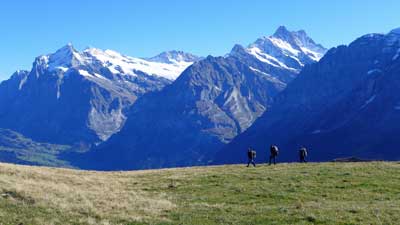
- Glacier Express
- Route: Zermatt to St. Moritz
- Train type: Panorama
- Journey time: 8 hours 3 minutes
- Distance: 291km
- 1st Class fare: CHF272
- 2nd Class fare: CHF159
- Compulsory seat reservation fee: CHF44 or 49
- Supplement for Swiss Pass holders: 13 to 33 for panorama carriage
- Bernina Express
- Route: Chur to Tirano and Lugano
- Train type: Panorama and bus
- Journey time: 4 hours 13 minutes and 3 hours 10 minutes
- Distance: 148km and 90km
- 1st Class fare: CHF113
- 2nd Class fare: CHF66
- Compulsory seat reservation fee: CHF32
- Supplement for Swiss Pass holders: 10 to 14 for panorama carriage
- GoldenPass Line
- Route: Lucerne to Montreaux
- Train type: Panorama
- Journey time: 5 hours 8 minutes
- Distance: 191 km
- Prestige Class fare: CHF131
- 1st Class fare: CHF96
- 2nd Class fare: CHF56
- Supplement for Swiss Pass holders: 8 to 15 for panorama carriage
- Gotthard Panorama Express (formerly Wilhelm Tell Express)
- Route: Lugano or Locarno to Lucerne
- Train type: Panorama and boat
- Journey time: 5 hours 21 minutes
- Distance: 182 km
- 1st Class fare: CHF164
- 2nd Class fare: CHF135
- Supplement for Swiss Pass holders: 39 to 49 for panorama carriage
- Swiss Chocolate Train
- Route: Montreux to Broc round trip
- Train type: Panorama or First Class
- Journey time: X hours X minutes
- Distance: 82 km
- 1st Class fare: CHF99
- 2nd Class fare: 89
- Supplement for Swiss Pass holders: 39
Popular Swiss scenic and theme trains
The scenic trains below are also extremely popular as sightseeing journeys rather than just as transportation, but can be used as both.
- Jungfraujoch round trip
- Route: Interlaken to Jungfraujoch
- Train type: special mountain train
- Journey time: 4 hours 41 minutes, round trip, plus time on top
- Distance: 73 km
- 1st Class fare: N/A
- 2nd Class fare: CHF224
- Supplement for Swiss Pass holders: 147 (so, a saving of CHF77)
- Gornergrat Railway
- Route: Gornergrat Railway
- Train type: Cog railway
- Journey time: 44 minutes return
- Distance: 10 km
- 1st Class fare: N/A
- 2nd Class fare: CHF90
- Supplement for Swiss Pass holders: 45
- Rigi round trip
- Route: Lucerne to Rigi
- Train type: Cog railway
- Journey time: 3 hours 25 minutes, plus time at the top
- Distance: 58 km
- 2nd Class fare: CHF78
- Supplement for Swiss Pass holders: None (this one is free with the pass)
- Mt Rigi Excursion (one-way and walk down)
- Route: Lucerne to Mt Rigi
- Train type: cogwheel train and/or cable car
- Journey time: 45 minutes up
- 1st Class fare: N/A
- 2nd Class fare: 49
- Supplement for Swiss Pass holders: 0
- Lotschberg Mountain Route and Centrovalli
- Route: Bern to Locarno
- Train type: Narrow gauge
- Journey time: 4 hours 40 minutes
- Distance: 212 km
- 1st Class fare: CHF158
- 2nd Class fare: CHF90
- Supplement for Swiss Pass holders: 5
- Jura round trip (Watchmaking Tour)
- Route: Neuchatel through Jura
- Train type: Regular
- Journey time: 3 hours 0 minutes
- Distance: 143 km
- 1st Class fare: CHF168
- 2nd Class fare: CHF108
- Supplement for Swiss Pass holders: 0
- Pre-Alpine Express
- Route: St. Gallen to Lucerne
- Train type: Regular
- Journey time: 2 hours 15 minutes
- Distance: 146 km
- 1st Class fare: CHF83
- 2nd Class fare: CHF47
- Supplement for Swiss Pass holders: 0
- Jura Foot Line
- Route: Basel to Geneva
- Train type: Regular
- Journey time: 2 hours 40 minutes
- Distance: 248 km
- 1st Class fare: CHF132
- 2nd Class fare: CHF75
- Supplement for Swiss Pass holders: 0
Popular Switzerland cable car rides
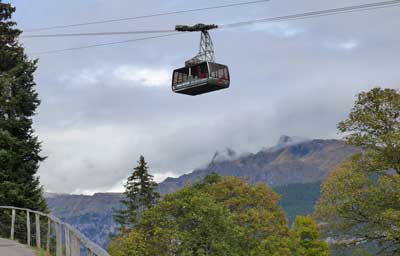
- Schilthorn
- Route: Stechelberg (Lauterbrunnen) to Schilthorn
- Train type: cable car
- Journey time: 1 hour
- 2nd Class fare: CHF108
- Supplement for Swiss Pass holders: 54
- Engelberg to Mt. Titlis cable car
- Route: Engelberg to Mt. Titlis
- Train type: cable car
- 2nd Class fare: CHF96
- Supplement for Swiss Pass holders: 46
The Swiss Travel Pass also includes free museum admission, but…
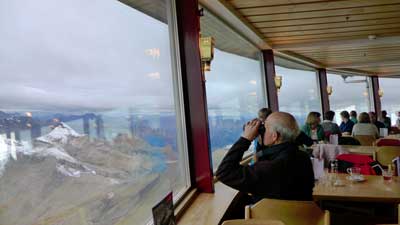
The problem is that the museums are only free on valid travel days, and almost no one would visit more than one or two museums with a Swiss Travel Pass. The trains and cable cars are so expensive that the pass gives very good value to cover those, so you don’t want to waste precious sightseeing time walking through a museum that only costs CHF10 anyway.
In other words, calculate the value of a Swiss Travel Pass on the travel savings only, and if you visit a museum here or there, then great. Most people are better off trying to squeeze in an additional train ride each day, and ignoring the museums. Switzerland is all about the outdoor scenery. As nice as the museums may be, they are not why you are there.
The pass includes free public transport in most Swiss cities
Similar to the free museum part of the offer, it’s best to ignore or minimize the value of free public transportation. It could be helpful in Zurich, but in most other Swiss tourist towns you won’t need much public transport. In fact, in Interlaken, each hotel or hostel guest automatically gets a card for free public transportation within the town (including between the two train stations).
So you might use a ride or two each day on public transport, but that won’t add up to much in terms of value of your Swiss Travel Pass.

Thank you so much for this post. It’s really helpful for our planning.
Couple of friends and I are going to Switzerland next month and are still unsure which direction to take. Our rough itinerary is
– day 1 Basel- Interlaken
– 2 – train to Lucerne and go up Mt Pilatus
– 3 – travel from Lucerne to Stoos/ Schwyz and do Fronalpstock (which would include funiculars)
– 4 – take a train to Lauterbrunnen
– 5 – take a train to Montreaux
– 6 – train to Lausanne for the day and then to Geneva to fly out
Each day would involve training to the place and then probably a couple of shorter trips to do an activity in the area and we’re struggling to figure out the best (most economical) way to do this. Would you by any chance have any advice on this? Really really appreciate it.
Lindsay,
I can see your issue. I think I’d start by reorganizing the itinerary and definitely spending more than one night in a couple places. Interlaken and Lauterbrunnen are about 20 minutes apart by a slow train so I wouldn’t backtrack to go there twice. In fact, I’d try to spend 2 nights in the Lauterbrunnen Valley in one of the villages so you have more time to hike and take cable car rides. It’s honestly the most beautiful spot in Europe.
I used to take trips like this where I would take trains between cities and towns and then enjoy the best of each one in a short time, but Switzerland is a bit different. The cities are almost all pretty disappointing, with the possible exception of Bern, and the famous mountain areas are absolutely amazing. In other words, it might be interesting to take a train through Montreux and Lausanne (and Basel for that matter), and maybe get out and walk around town for a couple hours, but I wouldn’t spend more time than that if it means spending so little time in the Interlaken, Lucerne, and Zermatt areas. Switzerland is a really unusual place within Europe. Also, the cities are extremely expensive even though they aren’t nearly as interesting as similarly sized cities in neighboring countries.
Maybe have a scan of my article about where to go in Switzerland and see if that inspires you at all? You can see a lot of Switzerland in 6 days and almost every ride in the country is extremely scenic and I’m sure you’ll enjoy it however you do it.
And it sounds like you are planning a lot of train travel and not many cable cars or boat rides. If that’s the case you might be best off getting a Half Fare Card for each person, as those at least keep the train rides reasonable. Let me know if you have any other questions. -Roger
Hi Roger,
Thank you so much for this. Just the kind of advice we needed and this is greatly appreciated. Will do some reorganising for sure.
Will definitely read that blog, really appreciate the tips. Thank you!
– Linds
Hi Roger,
Thanks so much for all your effort for this blog great info.
My husband and are are travelling to Switzerland in September, flying into Zurich with the plan to catch a train straight to Lucern for 3 days, during this time we would like to go up to Mt Pilatus and also to Grindelwald – First. Then train back to Zurich for 1 day/ night – not committed to any plans in Zurich yet, open to suggestions but and trying to decide whether it would be best to get a 4 day swiss travel pass or a 1/2 price card?
Thanks Robyn.
Robyn,
It always depends on just how many things you’d use a Swiss Rail Pass on during those days, and so far your schedule doesn’t sound too full. If that’s the case then the Half Fare Card is probably your best option. You might have a closer look at the Swiss Travel Pass and what it covers. It’s very likely that you’ll see a few more things that are covered that you could fit into your trip. And if that is the case then the Pass might be a better deal. But if you don’t plan on doing many more boat rides or cable car rides and such, the Half Fare Card is probably best. Let me know if you have any other questions. -Roger
Hi Roger, thanks for this detailed review about the Swiss travel pass. But I am still confused about what to get for our Swiss trip this September. We, my husband and I, will stay be there for 4d3n and booked our hotel in Zurich. We are planning to go to Lucerne, Mt Titlis, Mt First, & Interlaken. We are planning to get the 4-day Swiss pass but I am still not very sure if that’s the right choice. We could also go to Mt Rigi if we decided to buy that pass. I hope you could give me some advice. Thanks and all the best
Jen,
If you’ve already booked and locked-in a hotel in Zurich then I think a 4-day Swiss Travel Pass is going to be your best choice. Not only will you be using for the various mountain attractions that you mentioned, but you’ll also be using it extensively just getting back and forth to Zurich each day. It’s very handy to use the pass on the trains because you can literally just walk into the station whenever you are ready and hop on the next departing train and grab a seat. With a Half Fare Card you’d have to buy those train tickets each time.
And as I always say, once you are there with the full pass, you’ll come across other things that it covers that you’d like to do. So the train from Zurich to Lucerne and then the lake cruise in Lucerne leaving from just across from the train station, and then a cable car up the mountain once you jump off the boat in a small town. Or if you finish your activity early you might hop on another train to another town and find a boat ride or cable car there. It’ SO nice to just be able to do almost anything and not have to worry about the cost.
All of that said, I’m not a big fan of staying in Zurich if there are other options. I prefer to spend evenings in Lucerne or the Lauterbrunnen Valley, where hotels are actually a bit cheaper as well. So if you don’t spend all 4 nights in Zurich it might be a bit different, but I still think the pass is probably the best choice. Let me know if you have any other questions. -Roger
Hi, Roger! Thank you for putting this together for confused travelers like us. I was initially leaning on buying the Swiss Travel Pass since we’ll be in Switzerland for 12 days. However, since we’ll be staying a few days in each destination, I don’t know if perhaps the half-fare card is the way to go. Here’s our itinerary:
1 night in Zurich
Bernina Express to Lugano
3 nights in Lugano (with day trip to Lake Como)
2 nights in Zermatt
4 nights in Lauterbrunnen Valley (Schilthorn peak)
1 night in Lucerne
1 night in Zurich
What are your thoughts? Thank you in advance
Sarah,
I’m glad this was helpful. There are two possible strategies you could use. On one hand, the 15-day Swiss Travel Pass is so cheap on a per-day basis that even for a 12-day visit, I think it’s probably your best option. Based on your itinerary you’ll definitely get quite a bit of use out of it, and then when you are actually there you’ll stumble across (or pre-plan them) quite a few things that will be free with the pass. There are tourist trains and cable cars and boat rides and almost all of them are fully covered by the pass. At a bit under US$500 per adult in 2nd Class for a 15-day pass, it still works out to a bit over US$40 per day over the 12 days. And everything in Switzerland is absurdly expensive at full price, partly because nearly everyone uses a Half Fare Card or a pass. In other words, you’ll probably get US$500 use out of each pass in the first 7 or 8 days even if you don’t try too hard. Also, it’s more fun to have a pass and just climb on board almost any train or boat or cable car you see.
The other strategy would be a bit cheaper and could be better if you don’t think you’ll want to do many other spontaneous train rides and cable cars and such. You could buy a Half Fare Card and then buy a Saver Day Pass (at least a month in advance) for each heavy travel day such as the Bernina Express and the Zermatt to Lauterbrunnen days. And obviously you’d still be able to ride trains and cable cars for half price during the whole trip. That might be around US$400 per person if you don’t do much else aside from what’s on your list.
Again, I’d recommend the 15-day pass and I’m sure you’ll get a LOT of use out of it. But you could potentially save a bit if you did it the other way and didn’t do much else. Let me know if you have any other questions. -Roger
Thanks for such a great article. I’m travelling to a Switzerland on 20/5/23 for a week with my wife and 3 children 6,9 & 11. We fly into Basel have one night there then we have 4 nights in interlaken (with a trip to Junfraujach) then 2 nights in Geneva before taking a train to Venice, only accomodation is booked. I was initially planning on the Swiss card for my wife and I thinking the kids would get free travel. I’m now wondering if we should maybe get the 50% and try a day saver for the train trip Basel- Interlaken and Interlaken to Geneva. We plan to hike around Interlaken so it may work out well to rest kids on public transport at other times. Do you mind giving your thoughts on which card to use or anything I’m missing. Thanks
Chris,
I’m glad this helped. As always, it’s tough for me to confidently recommend a pass without knowing how much it will be used, and even then it’s a matter of adding it all up and figuring out which way is cheaper. That said, I think the strategy of getting a Half Fare Card and then a Saver Day Pass for the days when you’d do expensive things that are fully covered by the Swiss Travel Pass is probably the best way for many people. The Half Fare Card will obviously save a lot on its own, and then if you can combine the expensive things into a couple of specific days, it’s quite a bit cheaper than a full pass for the whole trip.
Of course, one key with the Saver Day Passes is to buy them at least a month or more in advance. Their price goes up as the day approaches and they are much cheaper when bought early. And you should be able to order a free Swiss Family Card as well, which will cover the kids. Let me know if you have any other questions. -Roger
Hello,
I would like to know your opinion on belowI am planning to travel Switzerland in mid of April for two weeks with my baby and husband.The climate is mostly rainy and cold.What would you suggest on this and also which travel pass is recommended.
Sanjoli,
That is a pretty open-ended question. First I’d suggest having a scan of this article on where to go in Switzerland, which gives my best advice on itineraries and should give you plenty of ideas.
And I wouldn’t worry too much about the April weather in Switzerland. The summer months are generally the wettest and also warmest, of course. Fortunately, Switzerland is not a place where it tends to rain all day for days on end. Usually you’ll have a storm for a few hours and then it clears up, although that can happen a few days in a row. There is no perfect warm and dry season to visit Switzerland so you kind of have to take the bad with the good.
Also, the best sights involve the mountain tops such as the Jungfraujoch railway and Schilthorn cable car in the Lauterbrunnen Valley, and it can be foggy on those mountain tops any day of the year, including the warmest days of summer. Generally that tends to only happen for part of a day so often the morning is clear and the afternoon is fogged in, and sometimes the other way around. You just have to dress in layers and keep backup plans if it happens to start raining. For example, if it’s supposed to be rainy much of tomorrow, it can be a good day to take a day trip to Bern, which often has different weather and is still really interesting if you get a bit of rain. I hope this helps and let me know if you have any other questions. -Roger
Roger: this will be of interest to those headed into Lauterbrunnen Valley, especially Schilthorn, and Jungfrau. It’s a list of scheduled closures of the various lifts.
https://holidaystoswitzerland.com/cable-car-and-funicular-closures-winter/
Best, MPB
Thank you for your very helpful info. You are awesome! 🙂
The various tourism sites have each given me different recommendations of other passes, the Jungfrau region pass, the top of Europe pass, the Berner Overland pass, to add to the swiss half fare, so I am still confused. Where do I find the prices for this year so I can do comparisons? What confuses me is all the gondolas, cable cars ect.. as we plan to do a lot of hiking. We will be coming in June, taking the train everywhere, Zurich to Interlaken 1 night, to Grindelwald 1night, Jungfraujoch, Lauterbrunnen 1 night, then to Zermatt/matterhorn 2 nights, to Schaffhausen 1 night, to Stein im Rhine then to Zurich.
Thank you from Oregon!
Cyndi,
As you’ve seen, you are not alone in being confused by all of this. That said, I think the main Swiss Travel Pass is probably your best bet since you’ll be going to several different areas around the country. I find that the top Google results are pretty good at showing the current prices, but you’d never know about all of the passes without a lot more research.
My best recommendation in cases like this is to first look at the Swiss Travel Pass and what is included in it, and then see how many of those things you are planning on doing or might add to your trip. It could be worth changing plans a bit to include a couple other “free” things instead of ones that you’d have to pay full or even half price for. And also, when you are actually IN Switzerland you’ll almost certainly encounter other things along the way that look interesting, and nearly all of them will be included free with the Swiss Travel Pass. That’s why I think it’s worth getting even if it’s a close call by price. I hope this helps. -Roger
Hi Roger.
I’m glad to have found this article . You pretty much summed up what I was looking for.
Will be traveling to Switzerland May21-26 and planned on making Zurich our base.
Wanted to see Jungfrauhjoch and Lucerne Mt Titlis. Will also be going to St Gallen to visit my nephew at the university.
Considering the cost between Swiss travel pass vs guided tours from Zurich, I found it with little difference.
I’m thinking the STP or 1/2 fare but it means self guided tours.
Do you have advice for me which is a better option?
Traveling from NY
Thank you so much!
Best regards
Caroline
Caroline,
I’m glad you found this as well. My first suggestion would be to NOT make Zurich your base, at least not for the entire trip. Zurich is a pleasant city known for banks, watches, and really high prices on everything. The rest of Switzerland is known for breathtaking beauty. Have at least a scan of this article about where to go in Switzerland and hopefully you’ll want to spend at least parts of your trip in the Lauterbrunnen Valley and also in Lucerne. Those places are absolutely stunning and spending nights in them will be unforgettable and also cheaper than Zurich. If you are somehow getting a free or cheap room in Zurich then it could be a good place to stay for a couple nights and you can see some things from there.
My hunch is the guided tours are fairly inflexible and also quite expensive. Switzerland is very easy to tour on your own and all the important signs are in English, and almost everyone you encounter as a tourist will speak English as well. I’d recommend splurging on a Swiss Travel Pass and then just going where you please rather than being picked up from a Zurich hotel each morning for a specific itinerary. I’m happy to answer more questions if you have them. -Roger
Hi Roger
First of all , I have to say I am so glad that I found your blog. I am planning 6 day trip landing 26th May 9pm in Zurich and returning back to UK on 1st June.
We are family of 4 (include 2 children 11yrs old).
We are looking to stay 1 night in Zurich, 3 nights in Luzern and 2 nights in Interlaken before catching flight back from Zurich on 1st June.
Looking to cover Rhine falls, Luzern sight seeing, Mt Titlis, Mt pilates, Mt Jungfrau and ideally Interlaken paragliding.
I am thinking half care card would be value for money but not sure if its close call as compared to swiss pass. Also I wasn’t sure whether for 5 days should just stay in Luzern and do trips from there (instead of moving to Interlaken).
Your expert opinion would be greatly appreciated
Looking forward to your response.
Thanks
Vikram
Vikram,
I’m glad you found this site as well. Your trip sounds great. I’m not alone in the opinion that the Lauterbrunnen Valley is arguably the most beautiful part of Europe, and even quite a bit more impressive than Lucerne. So I would spend those two nights there, hopefully in one of the mountain villages rather than in Interlaken itself.
It’s hard to judge the value of a Swiss Travel Pass without listing all of the things you’d do with it, but my hunch is that you’d get the best value with a 6-day pass, and your kids can travel for free with the complimentary Swiss Family Card that you can request at the same time. Once you are in Switzerland you’ll find more trains, boats, and cable cars that you’d like to ride, and with the full pass you can just hop on board. With a Half Fare Card some things are still somewhat expensive so it’s a really great luxury to just pay in advance and live like royalty. I’m sure you’ll have a great trip either way. -Roger